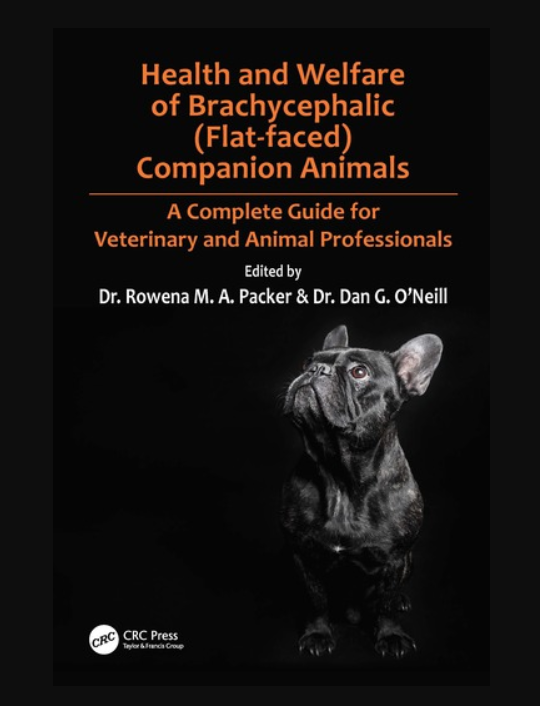Veterinarians and Brachycephalic Dogs - Ethics and Reality
Veterinarians and Brachycephalic Dogs - Ethics and Reality
 I have been starting to read the new textbook, Health and Welfare of Brachycephalic (Flat-faced) Companion Animals - A Complete Guide for Veterinary and Animal Professionals, Edited By Rowena Packer, Dan O'Neill; Copyright Year 2021 (ref below). This book has two parts. The first part offers a group of articles on the backgrounds, history, ethics, international developments, and other aspects that define and impinge on the health and welfare challenges of dogs with flat faces. The second part is a veterinary textbook on the current treatment methods, strategies, and surgeries that are needed in these breeds who are at high risk of respiratory, eye, spinal, skin, and many other problems. Everyone who cares about dogs should read part one. We'll leave the vets to follow the pertinent bits in part two - BUT - it is crucially important that all practising vets read and consider the issues and challenges described in part one. I hope to write several blogs on various articles and issues from the text.
I have been starting to read the new textbook, Health and Welfare of Brachycephalic (Flat-faced) Companion Animals - A Complete Guide for Veterinary and Animal Professionals, Edited By Rowena Packer, Dan O'Neill; Copyright Year 2021 (ref below). This book has two parts. The first part offers a group of articles on the backgrounds, history, ethics, international developments, and other aspects that define and impinge on the health and welfare challenges of dogs with flat faces. The second part is a veterinary textbook on the current treatment methods, strategies, and surgeries that are needed in these breeds who are at high risk of respiratory, eye, spinal, skin, and many other problems. Everyone who cares about dogs should read part one. We'll leave the vets to follow the pertinent bits in part two - BUT - it is crucially important that all practising vets read and consider the issues and challenges described in part one. I hope to write several blogs on various articles and issues from the text.
The book should be recognized as a major accomplishment. As an author of the chapter International and National Approaches to Brachycephalic Breed Health Reforms in Dogs – work started a couple of years ago - I can attest to not being sure at first that we needed this text and wondering if it would still be vital by the time it was published. Well, the book is published, e-versions are available, and hard copies will ship soon. And the issues of brachycephalic – flat-faced – dogs are still very much a hot topic and a worldwide concern. Dr. Packer says in Chapter 3, Why Do People Love Brachycephalic Dogs and Keep Coming Back for More? "When reflecting on the paradoxical situation we face in 2020, where more than ever is known about the poor health of brachycephalic dogs, but yet their popularity is at an all-time high, the question of why owners are drawn to brachycephalic breeds, and even in the face of chronic or severe health problems, continue to show loyalty towards these breeds, is critically important to explore." Challenges are as bad or worse in 2021...
Chapter 3 goes on to state that: "In a study of American Kennel Club registrations, health and longevity were not correlated with breed popularity, and on the contrary, the most popular breeds tended to have significant health problems (Ghirlanda et al. 2013)." "In the same study described above, owners’ perceptions of ‘good health’ were further revealed to be misaligned with what veterinary professionals may consider ‘good health’. " Owners in various studies (on brachycephaly and spinal problems) have been shown to underestimate the degree of health problems in their dog, presumably because they assume these things are 'normal' for the breed. "Owners reported which disorders their dog had previously been diagnosed with, the most common of which were allergies (27.0%), corneal ulcers (15.4%), skin fold infections (15.0%) and BOAS (11.8%). In addition, one fifth (19.9%) of owners reported that their dog had undergone one or more conformation-related surgeries. Despite relatively high levels of disease reported in this young population (mean age just 2.17 years), most owners in this population paradoxically perceived their dogs to be in the ‘best health possible’ (30.0%) or ‘very good health’ (40.9%)."
It doesn't take much to then see the challenges for veterinarians who attend such dogs. Chapter 4 Ethical Challenges of Treating Brachycephalic Dogs was written by Anne Quain and Paul McGreevy, University of Sydney and Siobhan Mullan, University College Dublin. This chapter is a straightforward presentation of ethics and will be very hard hitting for all that are facing up to the challenges of these dogs, but especially vets in practice. “Ethically challenging situations, often described as ethical or moral dilemmas, are common in veterinary practice and are often stressful for veterinarians and their co-workers”. Veterinary organizations throughout the world are dealing with massively increasing rates of burnout and even suicide in the profession. With the increase in popularity of flat-faced dogs, clinics in most countries are having more brachys as clients - with all the attendant problems. The disconnect between many owners' lack understanding of the problems of these dogs, or their willingness to own them regardless of pain and suffering, and the expensive, heartbreaking, and never-ending medical, surgical, and humane issues dealt with by vets is ongoing. Chapter 4 goes through all this and more... including vets who 'role model' owning and breeding compromised breeds.
Veterinary professional organizations internationally and nationally have come out with various position statements and recommendations (e.g., FECAVA, WSAVA, BVA). They have called on multiple stakeholders to take responsibility, they have outlined work that should be done at the professional level and the practice level. However, they have often bypassed clear instructions for individual veterinarians, perhaps because they view that as a personal decision. But, with Chapter 4, it is easy to see that the ultimate - possibly hopeless challenges - land squarely on their shoulders on a daily basis. What balanced directions are there for the caring veterinary professionals, in an increasingly busy practice? How do they cope when appointments are too short and too packed to have life-changing discussions with a client? What options are there when up to 50% (or more) of practitioners (depending on country) now work in corporate practices where decisions about which clients to see, what major efforts can be undertaken is out of the average vet’s hands? And where making money is a harsh reality.
The many practical scenarios presented in Chapter 4 - in addition to the basic ethics approach - need to be read, digested, discussed, and brought into the reality that is veterinary practice today. Statements like the ones below must be combined with strategies to move forward in the current world of veterinary practice and amid the masses of brachycephalic dogs that come through the doors.
"The key ethical challenge in relation to brachycephalic dogs can be summarised thus: are veterinary professionals complicit in perpetuating welfare problems associated with extreme brachycephalic phenotypes?"
"Veterinary professionals who draw an income from involvement in breeding or treating dogs with extreme brachycephalic conformation have a potential conflict of interest between the interests of the animal and their own interests in drawing an income."
"The possibility of alienating a client by discussing their pet’s health should not discourage veterinarians from doing so."
"This concern [level of stress] underscores the need for veterinary professional associations to proactively educate members of the public about the health and welfare costs of extreme phenotypes, rather than leaving it to the individual veterinarian to act as the ‘moral hero’."
Education, however, is not enough. Human behaviour change is needed, and well-meaning position statements and suggestions will not do the trick.
Please read Chapter 4, or better still all of Part One of the text - no matter what stakeholder group you are in, veterinary or other or where you live - and be part of meaningful discussions. Or, sit back and deal with legislation that will come as a control of these problems.
References
Health and Welfare of Brachycephalic (Flat-faced) Companion Animals - A Complete Guide for Veterinary and Animal Professionals; Edited By Rowena Packer, Dan O'Neill; Copyright Year 2021. https://www.routledge.com/Health-and-Welfare-of-Brachycephalic-Flat-faced-Companion-Animals-A-Complete/Packer-ONeill/p/book/9780367207243?fbclid=IwAR2Z2AhWFHjtM-_is1nxFoZQhKkBCbRTHgxv7_Rv3b5OUeXHIv_ZMUmCwIE
Resources on DogWellNet.com including: Reframing Current Challenges Around Pedigree Dogs; Extremes of Conformation | Brachycephalics - includes links to FECAVA, BVA, other resources) https://dogwellnet.com/content/international-actions/extremes-of-conformation-brachycephalics/
Bonnnett, BN, Blog on DogWellNet.com: Do you know that veterinary well-being is a big issue? https://dogwellnet.com/blogs/entry/153-do-you-know-that-veterinary-well-being-is-a-big-issue/
IPFD in the WSAVA Bulletin: Dog Breeds: What you need to know about the Pug https://wsava.org/news/committees/dog-breeds-what-you-need-to-know-about-the-pug/
 Donate
Donate

0 Comments
Recommended Comments
There are no comments to display.